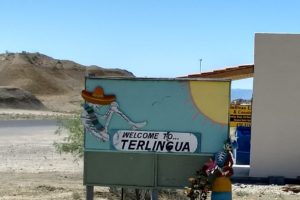Another strange name that I’ll tell you about later, but if I had known where we were going to be driving, I may have stayed home. But I didn’t so I went along for the ride. But . . . if you ever see this road sign, beware.

history
The Moki Dugway road winds 1200 feet from top to bottom on the 3 miles of graded gravel at an 11% grade. Gulp. It is a 2-lane road like what we’ve been used to but without shoulders, it appears to be much narrower! Drivers were courteous, thankfully, with those driving down stopping at a wider place for drivers going up the road.
When we got back down the road, we thought we were at the lowest level of land. But close by is Goosenecks State Park that has the familiar 1000-foot drop deep into the eroded landscape. We didn’t take the time to go there, but I am including this picture from one of the brochures we had picked up.

Before we start, though, let’s look at why this road was built and the meaning of the name.
Why: The road was built in the 1950s by Texas Zinc Minerals as a route for ore trucks hauling uranium and vanadium after WWII from Cedar Mesa at the top of the road to the processing mill near Mexican Hat (town) on the San Juan River that runs through the area toward the Colorado River. I can’t imagine the trucks, filled with raw ore, slowly navigating the roadway. Here’s a view of the river as we’re driving through Mexican Hat, named for a feature that looks like a Mexican hat just outside of town.

Meaning of the name: The term moki is derived from the Spanish word, moqui, a general term used by explorers in this region to describe Pueblo Indians they encountered, as well as the vanished Ancestral Puebloan culture. Dugway is a term used to describe a roadway carved from a hillside and is a means of traversing a steep hillside without sliding down the slope.
Are you ready to go yet?











So glad to be back on level ground. It wasn’t as bad as I thought it would be. Next stop is Valley of the Gods right next door to the Moki Dugway.




